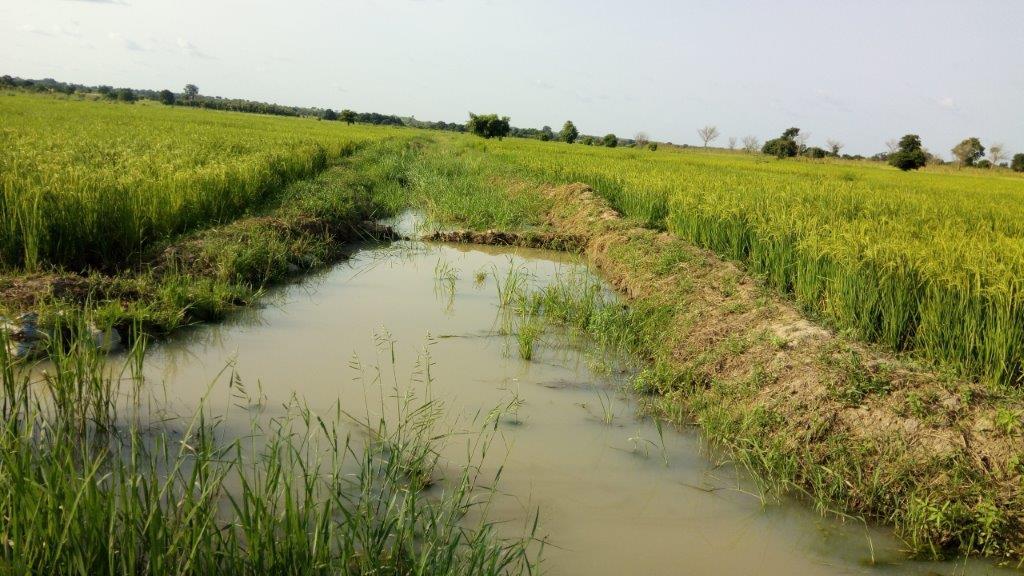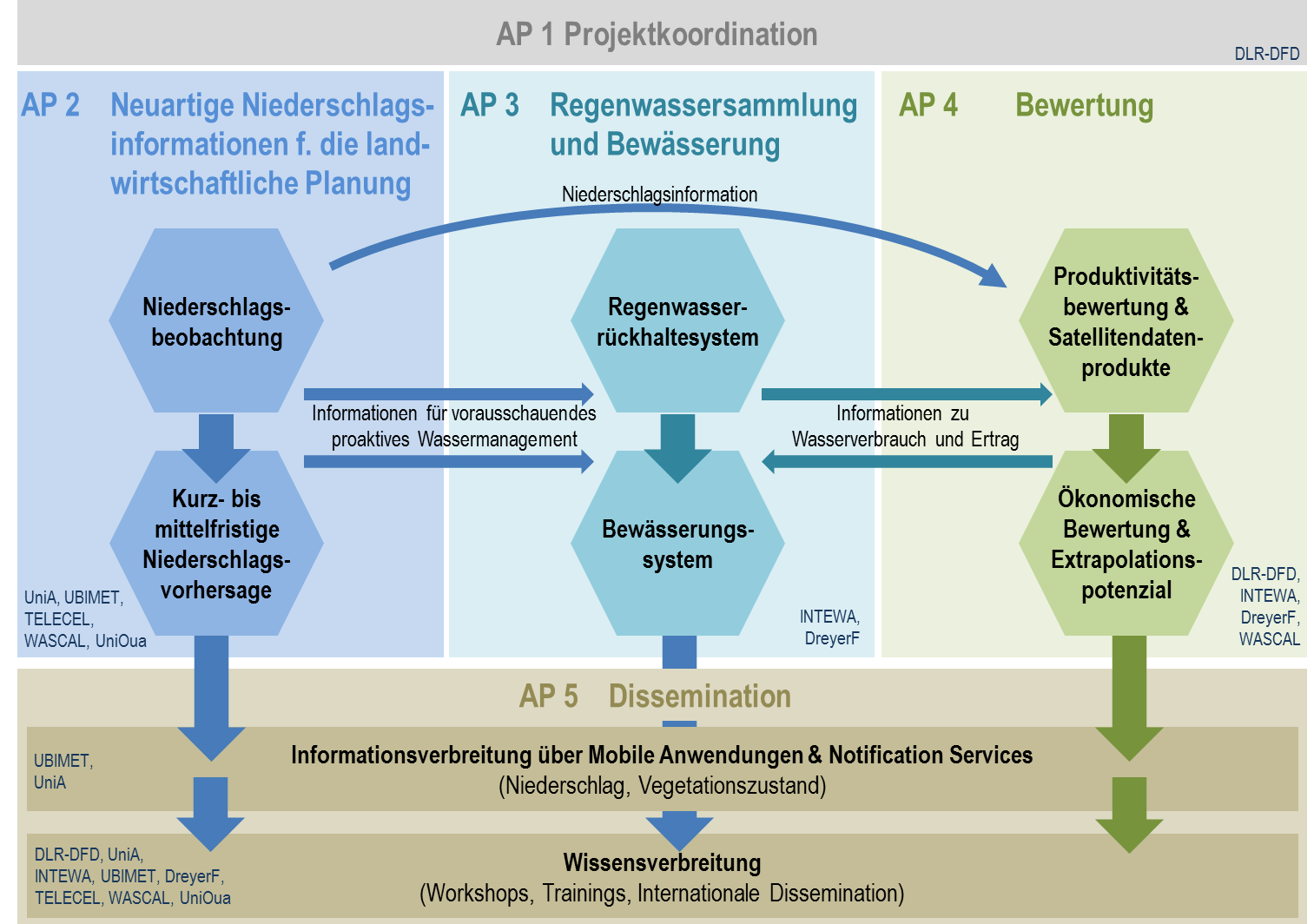

Zero hunger
Climate action
Partnerships for the goals
Clean water and sanitation
Project coordinator: DLR-DFD
Contact person: Jonas Meier
Address: Oberpfaffenhofen, 82234 Weßling
E-Mail: jonas.meier(at)dlr.de
Project partners in Germany:
- DLR-DFD, Weßling
- Universität Augsburg, Augsburg
- INTEWA, Aachen
- UBIMET, Wien (Austria)
Project partners in Burkina Faso:
- WASCAL, Ouagadougou (Burkina Faso)
- Dreyer Foundation, Dano (Burkina Faso)
- University Ouagadougou, Ouagadougou (Burkina Faso)
- Telecel-Faso, Ouagadougou (Burkina Faso)
Improved Precipitation Information and Use of Rainwater for Agriculture Adapted to Climate Variability in Burkina Faso
Climate change is one of the biggest challenges sub-Saharan Africa faces. Forecasts suggest that increasingly variable precipitation and rising temperatures may lead to crop yields falling by up to 50 percent. This affects the agricultural sector across Africa, including Burkina Faso, where the agricultural sector plays an essential economic role. Increasing the resilience of agriculture in Burkina Faso to the extremely variable precipitation is both one of the most important adaptation measures and one that holds great potential. AgRAIN is supporting these kinds of adaptation measures by aiming to make the use of rainwater more efficient.
Overall goal of the project
Extreme rainfall variability, and frequent droughts and floods pose a high risk to traditional rain-fed agriculture and food production in sub-Saharan Africa. The frequency of such events will increase as the climate changes. New strategies and technologies are therefore urgently needed to help the agricultural sector adapt to the negative effects of climate change. Burkina Faso often has variable rainy seasons, short dry spells and early rains, but extreme precipitation is also common. Consequently, the growing season is unpredictable, often shortened or interrupted, and this is a key reason for current crop failures in the country.
Two interlinked adaptation measures have great potential to increase the resilience of agriculture in Burkina Faso to extremely variable rainfall:
(i) Improvements to precipitation recording and forecasting for agricultural planning and
(ii) Optimised collection and storage of rainwater to be used for additional irrigation when necessary
The joint research project therefore aims: (i) to provide improved information about current and short-term expected precipitation in Burkina Faso, and (ii) to develop technologies that make intelligent use of this rainfall information to reduce the negative effects of rainfall variability on agricultural production, (iii) to assess the effectiveness and the extrapolation potential of the developed information and measures, and (iv) to apply prototypes of the new precipitation forecasting and water storage / irrigation systems to increase and stabilise the rice yield and for additional vegetable cultivation.
Thus, the project aims to overcome the challenge of climate change and land-use adaptation in order to minimise the vulnerability of agriculture and food production to variable rainfall.

Improving precipitation recording and forecasting for agricultural planning
Rainfall is measured using the commercial radio links of mobile operator Telecel-Faso (University of Augsburg). This measurement data is used to generate short and medium-term precipitation forecasts (UBIMET) in order to create a new and reliable basis of information for agricultural planning. High-quality, extensive precipitation measurements and short-term forecasts which were previously not possible will be made available to the public via the internet and/or mobile devices (UBIMET). This provides regional agriculture with essential data, for example for the efficient planning of irrigation, sowing and harvesting.
Optimised collection and storage of rainwater
An innovative underground rainwater storage system for collecting irrigation water from excess rain is being developed by INTEWA. The system is adapted to local needs, particularly in terms of costs, type of water storage and handling and therefore has good dissemination potential. Using excess rain for irrigation can increase yields, achieve a second crop rotation and reduce the risk of crop failure due to droughts. Monitoring the rainwater storage system with the help of the AgRAIN precipitation information increases the future efficiency of water storage and irrigation. Targeted underground infiltration of excess storage water can also replenish groundwater storage in the long term. A prototype system for rainwater storage and efficient irrigation will be installed at the Dreyer Foundation and linked to the precipitation forecasts.
Remote sensing and in-situ measurement techniques
Within the scope of the project, DLR-DFD and WASCAL will investigate and evaluate the effectiveness of the proposed rainwater collection and the irrigation measures that will become possible due to this collection. They will do this from both an economic and agronomic perspective by with the help of remote sensing and in-situ measurement techniques. Remote sensing-based data sets on the current development of vegetation on agricultural land are provided for all of Burkina Faso. This information – along with the above-mentioned precipitation information – can be used to improve agricultural management (e.g. irrigation, sowing, harvest times). The African partners are involved in all activities and support in the respective specialist areas, as well as in the implementation of fieldwork and installation on-site.

